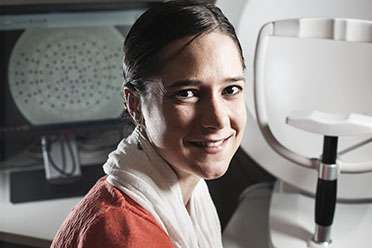QUT puts night-time vision problems in the spotlight

Do you struggle to see at night? A new QUT study is looking to uncover why some people over the age of 50 find their vision falters after dark and what eye tests might help to identify those at risk.
Janessa Kimlin, from QUT's Institute of Health and Biomedical Innovation, said about one third of older people report vision difficulties caused by glare, especially when driving, and their ability to see in dim light.
"There are many factors that have been linked to increases in glare disability and problems with vision in low light that increase as we age," Ms Kimlin said.
"As we get older, our eye changes and the lens inside the eye can form cataracts which cause a scattering of light within the eye making it harder to distinguish objects from their backgrounds, both in low light and also in situations with bright lights such as headline glare.
"Age is also linked to decreases in pupil size and neural changes that occur at the back of the eye and can affect the amount of light entering the eye, as well as how well we cope with glare and distinguish contrast.
"The problem is there are limited tests for these types of visual problems and those that are available are not widely used by eye care professionals."
Ms Kimlin has launched an online survey and will be conducting specialised eye tests to better understand night vision difficulties that occur as people get older.
"At the moment there are a number of eye tests that optometrists use to determine how well people can see including the common eye chart test," she said.
"Optometrists also use a visual field test and a pressure test to check for conditions like glaucoma.
"What my study will do is see whether eye tests performed under lower light conditions and with glare could help identify night-vision difficulties."
As part of the study, Ms Kimlin will be conducting a twilight vision assessment not commonly used in Australia.
"The twilight test, uses a specially designed piece of equipment that is only available from Germany, and assesses contrast sensitivity such as the ability to see shades of grey in both glary and dark conditions," Ms Kimlin said.
"I want to find out whether such a test could help identify Australians who have problems seeing in lower light conditions."
Ms Kimlin said many older people were concerned about night driving, with some giving up driving after dark because of their visual difficulties.
"Research has shown that older drivers are good at self-regulating their driving habits such as limiting their night driving, or not driving during peak-hour traffic but we need to be offering tests that can help older people more accurately understand and therefore manage changes to their vision," she said.
People over the age of 50 can take part in the online survey available at survey.qut.edu.au/f/180016/d9a3/ . As part of the survey participants can also nominate to take part in specialised vision testing at QUT's Kelvin Grove.

















